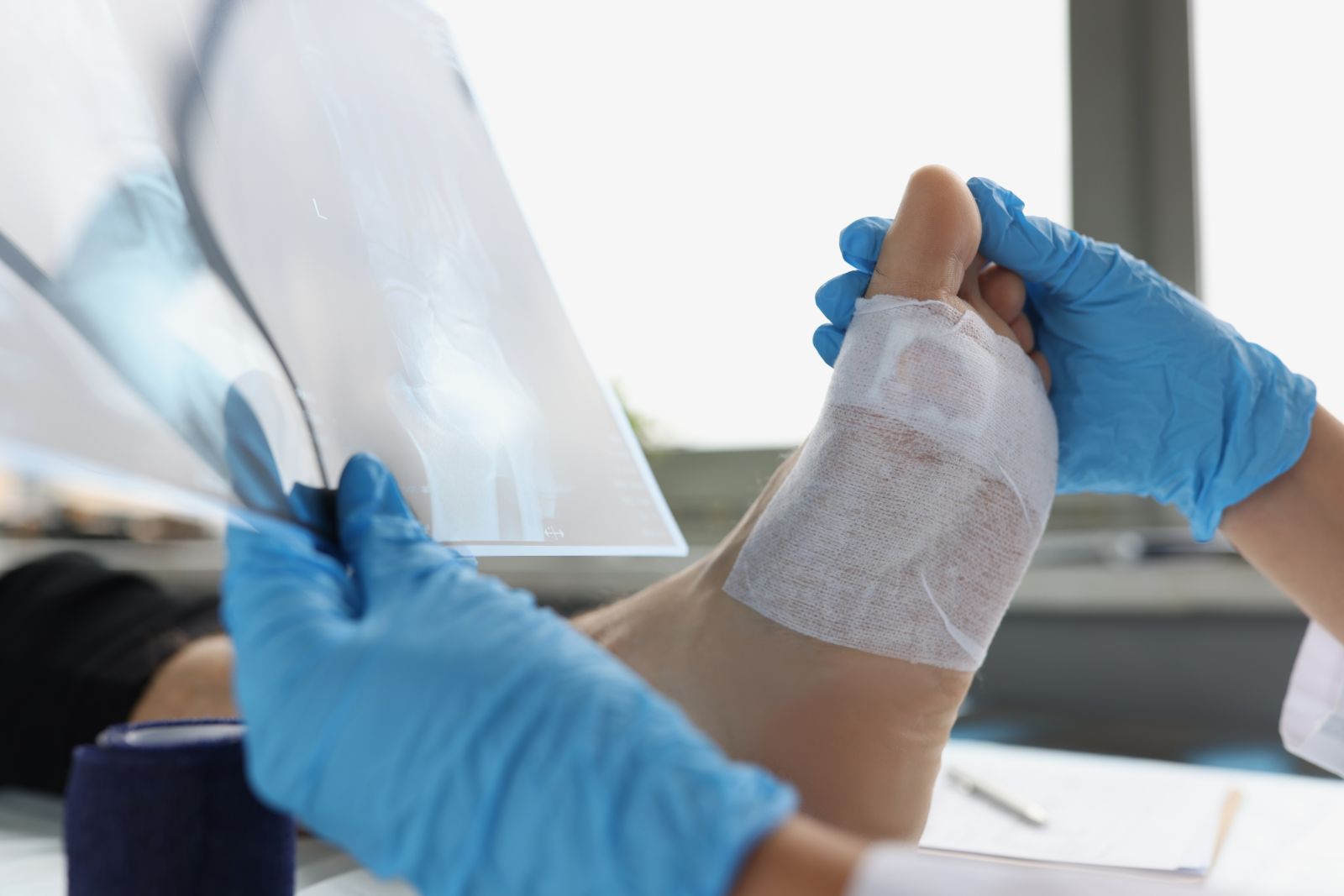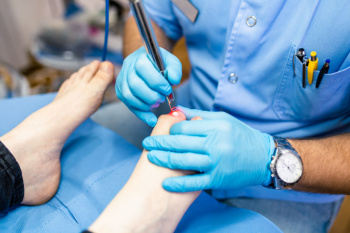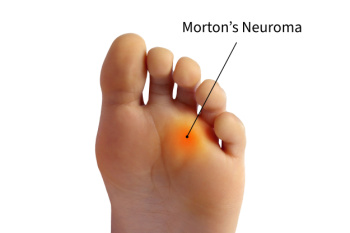Connect With Us
Blog
Items filtered by date: February 2025
Are You Suffering From Nerve Damage?
Types of Foot Surgery

Foot surgery can be performed on the joint of the big toe, the joints in the middle of the foot, the joints in the lesser toes, or the joints beneath the ankle when pain and mobility issues interfere with daily life. Fusion surgery, or arthrodesis, is often used for severe arthritis, where two or more bones are secured together with screws or plates to eliminate painful joint movement. Debridement, or cheilectomy, is a procedure that removes excess bone and tissue in the big toe joint to improve range of motion and relieve discomfort caused by bone spurs. Osteotomy is commonly performed for bunions, involving precise bone cuts to correct misalignment and stabilize the toe with screws or pins. Hemiarthroplasty is another option for arthritis in the big toe joint, where a synthetic implant is inserted to restore movement and reduce pain. A podiatrist can assess your particular foot problem and determine the most appropriate surgical approach. If you are experiencing foot pain, it is suggested that you schedule an appointment with a podiatrist for a diagnosis and appropriate treatment options.
Foot surgery is sometimes necessary to treat a foot ailment. To learn more, contact one of our podiatrists of Garnet & Carbonell, DPM, LLC. Our doctors will assist you with all of your foot and ankle needs.
When Is Surgery Necessary?
Foot and ankle surgery is generally reserved for cases in which less invasive, conservative procedures have failed to alleviate the problem. Some of the cases in which surgery may be necessary include:
- Removing foot deformities like bunions and bone spurs
- Severe arthritis that has caused bone issues
- Cosmetic reconstruction
What Types of Surgery Are There?
The type of surgery you receive will depend on the nature of the problem you have. Some of the possible surgeries include:
- Bunionectomy for painful bunions
- Surgical fusion for realignment of bones
- Neuropathy decompression surgery to treat nerve damage
Benefits of Surgery
Although surgery is usually a last resort, it can provide more complete pain relief compared to non-surgical methods and may allow you to finally resume full activity.
Surgical techniques have also become increasingly sophisticated. Techniques like endoscopic surgery allow for smaller incisions and faster recovery times.
If you have any questions, please feel free to contact our offices located in Palmetto Bay, South Miami, and Homestead, FL . We offer the newest diagnostic and treatment technologies for all your foot care needs.
Foot Fractures May Signal Osteoporosis
 Osteoporosis weakens bones, making them more prone to fractures, including those in the feet, toes, and ankles. A stress fracture in the foot, especially one that occurs with minimal impact or no clear cause, may be an early warning sign of this condition. Since osteoporosis, more common among women, reduces bone density, routine activities like walking or standing for long periods can lead to small, repetitive injuries that result in foot fractures. Women with this condition are particularly vulnerable to stress fractures in the metatarsals, which are the long bones in the foot that bear weight. Symptoms include pain, swelling, and difficulty walking. A podiatrist can assess the extent of the injury and recommend appropriate treatment options, which may include immobilization, supportive footwear, or surgery in severe cases. Identifying osteoporosis-related fractures early can help prevent further complications and support long-term foot health. If you have incurred a foot stress fracture, it is suggested that you schedule an appointment with a podiatrist for an exam and appropriate treatment.
Osteoporosis weakens bones, making them more prone to fractures, including those in the feet, toes, and ankles. A stress fracture in the foot, especially one that occurs with minimal impact or no clear cause, may be an early warning sign of this condition. Since osteoporosis, more common among women, reduces bone density, routine activities like walking or standing for long periods can lead to small, repetitive injuries that result in foot fractures. Women with this condition are particularly vulnerable to stress fractures in the metatarsals, which are the long bones in the foot that bear weight. Symptoms include pain, swelling, and difficulty walking. A podiatrist can assess the extent of the injury and recommend appropriate treatment options, which may include immobilization, supportive footwear, or surgery in severe cases. Identifying osteoporosis-related fractures early can help prevent further complications and support long-term foot health. If you have incurred a foot stress fracture, it is suggested that you schedule an appointment with a podiatrist for an exam and appropriate treatment.
A broken foot requires immediate medical attention and treatment. If you need your feet checked, contact one of our podiatrists from Garnet & Carbonell, DPM, LLC. Our doctors can provide the care you need to keep you pain-free and on your feet.
Broken Foot Causes, Symptoms, and Treatment
A broken foot is caused by one of the bones in the foot typically breaking when bended, crushed, or stretched beyond its natural capabilities. Usually the location of the fracture indicates how the break occurred, whether it was through an object, fall, or any other type of injury.
Common Symptoms of Broken Feet:
- Bruising
- Pain
- Redness
- Swelling
- Blue in color
- Numbness
- Cold
- Misshapen
- Cuts
- Deformities
Those that suspect they have a broken foot shoot seek urgent medical attention where a medical professional could diagnose the severity.
Treatment for broken bones varies depending on the cause, severity and location. Some will require the use of splints, casts or crutches while others could even involve surgery to repair the broken bones. Personal care includes the use of ice and keeping the foot stabilized and elevated.
If you have any questions, please feel free to contact our offices located in Palmetto Bay, South Miami, and Homestead, FL . We offer the newest diagnostic and treatment technologies for all your foot care needs.
Pros and Cons of Laser Toenail Treatment

Laser toenail treatment is an innovative procedure designed to treat fungal infections in the nails. The treatment works by using focused light to penetrate the nail and target the fungal cells, effectively killing the infection without harming the surrounding tissue. One of the main benefits of this treatment is that it is non-invasive and typically does not require recovery time, making it a convenient option for many. Additionally, it offers a high success rate with minimal side effects, such as slight discomfort during the procedure. However, there are some drawbacks to consider. Laser treatment can be expensive, and it may require multiple sessions to achieve the desired results. Furthermore, the effectiveness can vary depending on the severity of the infection and individual response. If you have toenail fungus and are considering this type of treatment, it is suggested that you consult with a podiatrist who can guide you on whether this treatment can help you.
Laser treatment can be an effective way to get rid of toenail fungus. If you have any questions about laser treatment, consult with one of our podiatrists from Garnet & Carbonell, DPM, LLC. Our doctors will assess your condition and provide you with quality treatment for fungal nails.
What Are Toenail Fungal Infections?
Onychomycosis, or fungal infection of the nail, is a relatively common and non-serious condition. Around 10 percent of U.S. citizens are afflicted with fungal nails. Common forms of fungus that infect the nail include dermatophytes, yeasts, and molds.
Symptoms of Toenail Fungal Infections Include:
- Nail thickening
- Brittleness of the nail
- Discoloration of the nail
Diagnosis for Fungal Nails
Fungal infections are diagnosed by fungal culture and microscopy. This will rule out any other conditions such as nail trauma, psoriasis, lichen planus, and onychogryphosis.
What Is Laser Treatment?
Laser treatment is a non-invasive, safe, quick, and painless procedure that uses the heat from a laser to kill fungus in the nail. Each infected nail is targeted with a laser for several minutes. The treatment is usually utilized several different times over a select period. During this time, a podiatrist will keep an eye on the infection.
If you have any questions, please feel free to contact our offices located in Palmetto Bay, South Miami, and Homestead, FL . We offer the newest diagnostic and treatment technologies for all your foot care needs.
What Is Morton’s Neuroma?

Morton’s neuroma is a painful condition caused by a thickening of tissue around a nerve between the toes, most commonly between the third and fourth toes. It often affects people who wear tight or high-heeled shoes, perform repetitive foot movements, or have foot issues like flat feet or bunions. Symptoms include a burning or sharp pain in the ball of the foot, tingling, or a sensation like there is a pebble in your shoe. The discomfort typically worsens with activity or pressure on the area. Relief options include wearing wider shoes, using cushioned insoles or pads, and taking anti-inflammatory medications. If you have severe pain from Morton’s neuroma, it is suggested that you see a podiatrist who may recommend corticosteroid injections, targeted exercises, or possibly surgery.
Morton’s neuroma is a very uncomfortable condition to live with. If you think you have Morton’s neuroma, contact one of our podiatrists of Garnet & Carbonell, DPM, LLC. Our doctors will attend to all of your foot care needs and answer any of your related questions.
Morton’s Neuroma
Morton's neuroma is a painful foot condition that commonly affects the areas between the second and third or third and fourth toe, although other areas of the foot are also susceptible. Morton’s neuroma is caused by an inflamed nerve in the foot that is being squeezed and aggravated by surrounding bones.
What Increases the Chances of Having Morton’s Neuroma?
- Ill-fitting high heels or shoes that add pressure to the toe or foot
- Jogging, running or any sport that involves constant impact to the foot
- Flat feet, bunions, and any other foot deformities
Morton’s neuroma is a very treatable condition. Orthotics and shoe inserts can often be used to alleviate the pain on the forefront of the feet. In more severe cases, corticosteroids can also be prescribed. In order to figure out the best treatment for your neuroma, it’s recommended to seek the care of a podiatrist who can diagnose your condition and provide different treatment options.
If you have any questions, please feel free to contact our offices located in Palmetto Bay, South Miami, and Homestead, FL . We offer the newest diagnostic and treatment technologies for all your foot care needs.

